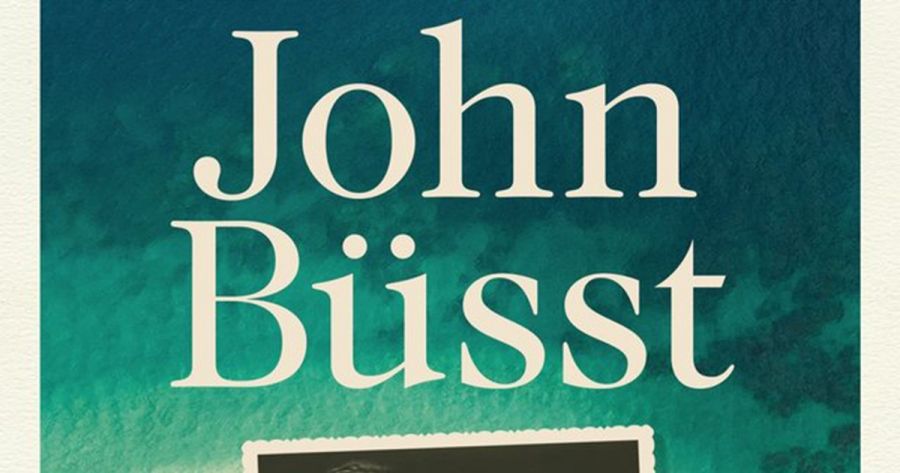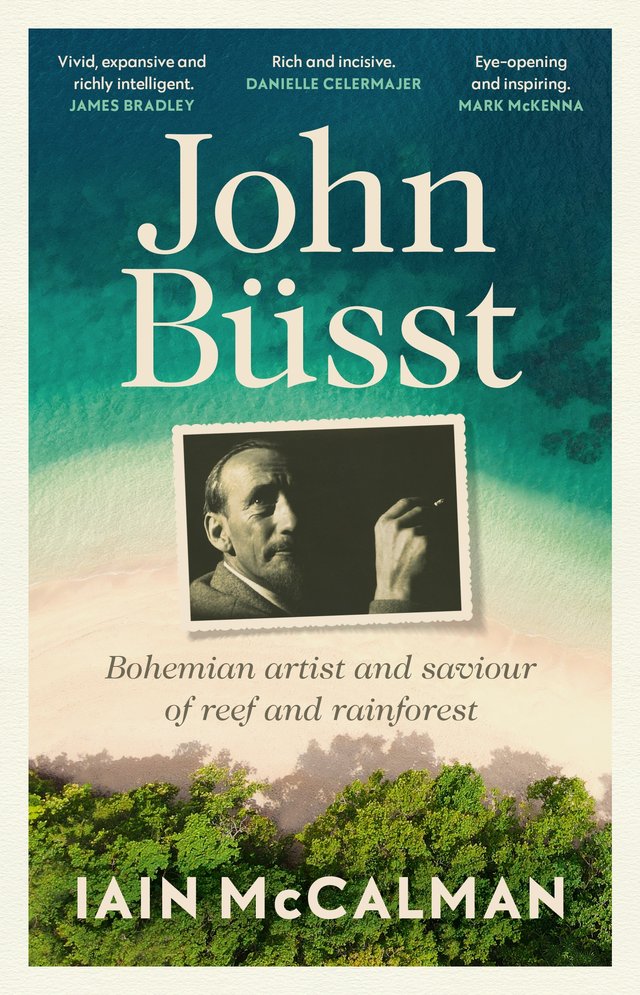
- Free Article: No
- Contents Category: Environment
- Review Article: Yes
- Article Title: ‘Good on you, mate!’
- Article Subtitle: A fearless and charismatic environmentalist
- Online Only: No
- Custom Highlight Text:
The ‘Bastard of Bingil Bay’ features on no banknote or coin, nor is he listed in any roll-call of ‘important Australians’, and yet, if it were not for John Büsst, it is likely that twenty-odd national parks and rainforest reserves on the far north-east coast of Queensland would not be so designated and might in fact have been obliterated. It is also probable that, without Büsst, today’s fight for the Great Barrier Reef would have already been lost, the vast ecosystem fragmented into a slew of cement quarries and cheap limestone pits. Considering the extent to which this vast coral labyrinth has shaped the identity of modern Australia, the relative absence of Büsst’s influence from the historical record is doubtless representative of the many such travesties historians seek to rectify.
- Featured Image (400px * 250px):

- Alt Tag (Featured Image): Anna Krien reviews ‘John Büsst: Bohemian artist and saviour of reef and rainforest’ by Iain McCalman
- Book 1 Title: John Büsst
- Book 1 Subtitle: Bohemian artist and saviour of reef and rainforest
- Book 1 Biblio: NewSouth, $36.99 pb, 263 pp
- Book 1 Cover Small (400 x 600):

- Book 1 Cover (800 x 1200):

- Book 1 Readings Link: https://www.readings.com.au/product/9781761170096/john-buesst--iain-mccalman--2024--9781761170096#rac:jokjjzr6ly9m
Enter McCalman’s new book, John Büsst: Bohemian artist and saviour of reef and rainforest, a biography dedicated to this unlikely conservation hero. McCalman begins in Bendigo, where Büsst was born in 1909 to an upper-middle-class Irish Catholic family of considerable wealth and influence. Horatio Busst (whose son later added the umlaut, wrongly believing they had German heritage) had high hopes for his children: John and his older sister, Phyllis. A mining warden (a position, McCalman later notes, that provided an important education for Büsst when he found himself in front of another mining warden arguing against a proposal to dredge a coral reef for fertiliser) turned managing director of what is now Bendigo Bank, Büsst Sr sent his children to private schools in Melbourne. Attending Wesley College, Büsst formed a lifelong friendship with future prime minister Harold Holt, later studying law at the University of Melbourne. At the age of twenty, Büsst, along with his sister, dropped out and fell in with Melbourne’s growing bohemian scene.
Here, McCalman depicts the smoky salons and artistic colonies of the city’s interwar years, a time when Büsst also seems to have come to life. Dropping out to become painters was a bit of a fig leaf, an attempt to assuage horrified and embarrassed parents at the time. But the bohemian scene was far more than a change of occupation, as McCalman illustrates; the Büsst siblings and their peers strove to live in a way that was in itself a work of art, rejecting society’s expectations and conventions. This decision, along with subsequent psychic distancing, created an irreparable rift between siblings and their father, though he continued to pay his children a living allowance.
It is much easier for the privileged to rebel. McCalman acknowledges this and suggests something quite vital about his subject. For it could also be said that Büsst, who blossomed as a craftsman, had embraced his privileged status with a keen sense of opportunity and, later, of duty to his country. His ability to stay connected to society, never rejecting it entirely, would prove invaluable. Later, while living in a failed artist colony on Bedarra Island in tropical Queensland, with its fringing coral reefs, Büsst fell in love with the natural world. The sea, he would later observe, held at least twenty-three different types of blue. While he hoped to be a painter, ultimately he conceded that he had little talent. But as a conservationist he thrived. After taking lessons in ecology from Webb, Büsst became a person of considerable zeal and influence, of a kind that North Queensland may not have been prepared for. In correspondence with Webb at the start of what would become a massive decade-long campaign to ‘Save the Reef’, Büsst wrote about living and breathing the Reef for nine weeks as he and colleagues mounted a court case. ‘You got me into this you bastard – and I’m enjoying every minute of it,’ he wrote. Büsst became known as the ‘Bingil Bay Bastard’ to his enemies: these included the military, keen to conduct Agent Orange experiments on remnant forests; local politicians who saw themselves as pioneers in Australia’s search for oil, and a sugar cane farmer who was keen to exploit ‘a dead reef’ for cheap fertiliser. Büsst wore the nickname with pride.
 Len Webb and John Büsst (from the book under review, J. and D. Webb, Janelle Devery, Wildlife.org)
Len Webb and John Büsst (from the book under review, J. and D. Webb, Janelle Devery, Wildlife.org)
Perhaps the sobriquet also highlights the reasons why Büsst is not widely celebrated. It was one thing to promote the Great Barrier Reef and the remaining Gondwana canopies of forests as calling cards for Australia’s unique beauty and to serve as credentials for being a good environmental citizen, but it was quite another to remember the ratbag conservationist who had fought for their protection. Enjoying one while loathing the other, this speaks to an ongoing incongruity when it comes to conservation in Australia where many are content to reap the subsequent accolades and profits but refuse to renege from general perceptions of conservationists as cranks, ratbags, and sentimental losers. McCalman rightly draws our attention to the missing piece that is Büsst. But his biography does much more than this. By bringing to light Büsst’s immense energy and political canniness – successfully influencing three serving prime ministers (including his dear friend Harry Holt), and a future one, Bob Hawke, who went on to persuade key unions to announce a blockade of oil rigs on the Reef – McCalman highlights the value of political and class unity when it comes to environmental campaigns. Büsst knew this, exploiting his connections in political circles and his raffish charm at the local Innisfail sugar cane festival, writing decisive letters of urgency to heads of agencies and respectable scientists to whom many others would have been too scared to say ‘boo’. At first Büsst’s confidence unnerved Webb, who came from a working-class background, then it delighted the forester when Büsst’s bold lobbying proved fruitful. Such was Büsst’s faith that his opinions mattered. What he did with his voice, even as it was literally taken away from him by throat cancer, was formidable.
After the publication of The Reef, residents of cyclone-ravaged Mission Beach just south of Cairns, where Büsst had lived and orchestrated numerous campaigns to survey and protect Queensland’s remnant tropical forests and the Great Barrier Reef, approached McCalman and told him of their plans to use his account of the friendship between Wright, Büsst, and Webb in order to rebuild their community. He accepted an invitation to Ninney Rise, the home Büsst had designed, complete with bamboo ceilings and still filled with his crafted furniture and paintings. Ostensibly the main headquarters of the Save the Reef campaign, the homestead was in a state of decay, though McCalman noted its enduring charm. The residents of Mission Beach wanted to see Büsst’s home heritage-listed and restored with the aim of its becoming a centre for artists and for reef and rainforest environmental research – a place of strength and commitment to art and ecological beauty.
McCalman became involved, his own commitments undoubtedly aligned. In the 1960s, Büsst not only fought the military’s plans to defoliate Queensland’s rainforests; he also persuaded them to become a powerful ally in the cause of conservation. Büsst knew his vision had to be shared to succeed – working those on the left and on the right, winning over conservatives such as Garfield Barwick and Labor lefties like George Georges.
Perhaps it is inevitable that few people know his name. Büsst was a conservationist who was never hemmed into a tribe or a group. ‘To drop quietly from a twig,’ a devastated Webb wrote of his beloved friend when he died a few years before the decision to protect the Reef. Now, with this fine book by Iain McCalman, we are able get to know the affable and effective ‘Bastard of Bingil Bay’.


Comments powered by CComment